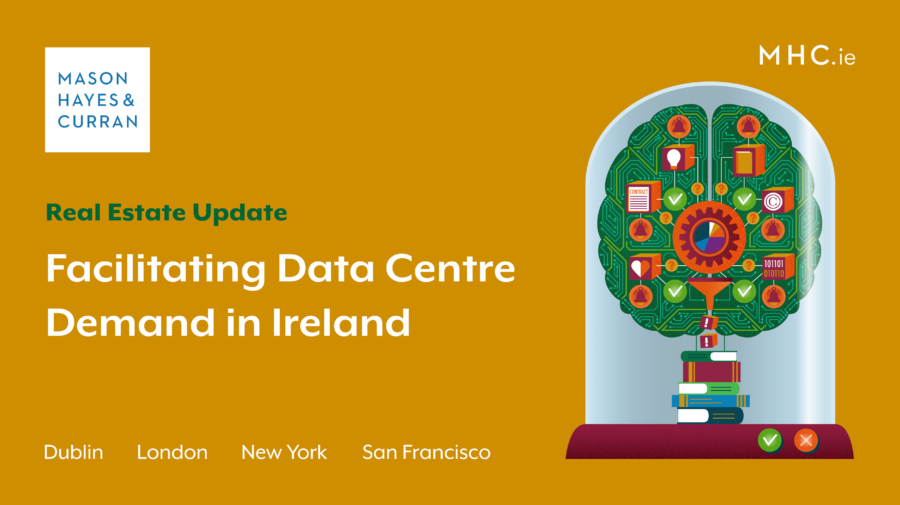Facilitating Data Centre Demand in Ireland

The current AI revolution presents Ireland with the opportunity to attract Foreign Direct Investment, particularly within the technology sector. Our Real Estate team discusses the critical importance of fostering an attractive environment for data centre development in Ireland.
Ireland is at a critical juncture in the technology and real estate sectors. The AI revolution is fuelling a surge in demand for data centres, presenting the country with a prime opportunity to attract significant Foreign Direct Investment (FDI). Yet, this promising influx of capital investment is facing material barriers. These include uncertain policy positions, regional moratoriums on data centre development, protracted permitting regimes and inadequate grid infrastructure. Prolonged uncertainty runs the risk of turning major technology companies and FDI away, toward countries that can step up to the plate. However, in terms of the critical aspects of grid, planning and availability of green power availability there are potential green shoots.
AI driving data centre demand
AI has significantly driven the demand for data centre capacity. As AI technologies scale globally, the amount of processed data has increased and the scale and power requirements of the data centres have increased. This growth necessitates the construction and development of more data centres. Ireland, traditionally a technology hub, benefits from strategic advantages like:
- Deep-sea fibre cables to the US and Europe
- A highly educated English-speaking workforce
- A cool climate with available clean water, and
- A low corporate tax rate
These naturally position Ireland to capture this wave of international investment. These factors would intuitively all point in one direction: Ireland being the location of choice for investment in data centre infrastructure.
This is a short-term opportunity for the Irish built environment sector to capitalise on the AI revolution but with the potential for very long-term gain. The need for data centre capacity and a fit-for-purpose consenting regime is immediate. Not only for the incumbent technology companies who already have, and are eager for more data centres, but also the new range of multinational companies that the AI revolution has revealed. These companies require data centres and may consider investing in Ireland as a location.
Regulatory hurdles
The issues predominantly lie with Ireland's regulatory landscape and energy constraints, which pose significant barriers to new infrastructure projects. Critically, planning regulations should soon become fit for purpose. The Planning & Development Bill 2023 is intended to speed up parts of the planning process. It has now been passed by Dáil Éireann, and it should soon be passed into law. It will still take some time before all provisions are enacted, however, once implemented it will present a streamlined planning system, which will improve and speed up the consenting process.
Grid infrastructure investment and policy also need to catch up with demand. As has been reported, there is uncertainty regarding the applicable grid connection policy for data centres connections generally and a moratorium in the Dublin region This uncertainty should be removed following the conclusion of the Large Energy User consultation process and an update in this regard should be forthcoming imminently. For example, the connection criteria implemented by the Commission for Regulation of Utilities, intended to manage energy consumption and grid strain, has stifled the development and delivery of data centre projects. This prohibitive environment has put approved projects at a standstill. This undoubtedly raises a red flag for technology companies thinking of locating in Ireland. As a result, it poses a significant roadblock to FDI into Ireland. To remain competitive and continue to attract investment, Ireland must urgently address the permitting and grid barriers.
A push for renewable energy
The delivery of data centre projects carries potential benefits for ancillary industries such as construction, engineering, technology and renewable energy. Importantly, ESG credentials hold significant weight for data centres, particularly in the wake of new sustainability reporting regulations. These requirements as well as planning permission conditions and CRU policy stipulations mean that the development of new data centres requires investment in green, renewable electricity initiatives that can be procured via Corporate Power Purchase Agreements. These have typically been procured using virtual power purchase agreement contract structures, however, the expected conclusion of the long-running private wire consultation should hopefully open up the potential for direct power arrangements between wind, solar and battery projects and large energy users, including data centres.
Conclusion
The clock is ticking and as technology companies set their sights elsewhere, Ireland must rise to the occasion, speed up its permitting and regulatory regimes and ensure energy generation solutions are available to facilitate the development of data centres. The window of opportunity is short, and a lucrative wave of FDI from AI-based technology companies is at stake.
For more information and expert, please contact a member of our Real Estate team.
The content of this article is provided for information purposes only and does not constitute legal or other advice.
People also ask
How many data centres are there in Ireland |
We have 82 data centres in Ireland, with a further 14 under construction and planning approved for 40 more, meaning a 65% growth in coming years. |
Why is Ireland popular for data centres |
Data centres are integral to Ireland's status as a tech hub, attracting multinational companies like Google, Facebook, and Amazon to establish their European headquarters. This appeal is driven by Ireland's well-educated workforce and favourable low corporate tax rate. |
How do data centres impact the environment? |
While data centres consume large amounts of energy, many are now implementing green initiatives to reduce their environmental footprint. This includes investing in renewable energy sources, improving energy efficiency, and implementing sustainable practices like waste recycling. |
Share this:






